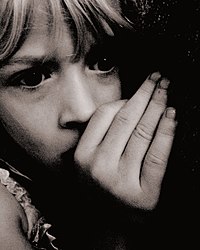
Photo from wikipedia
Predictability is an important characteristic of threat that impacts defensive motivation and attentional engagement. Supporting research has primarily focused on actual threat (e.g., shocks), and it is unclear whether the… Click to show full abstract
Predictability is an important characteristic of threat that impacts defensive motivation and attentional engagement. Supporting research has primarily focused on actual threat (e.g., shocks), and it is unclear whether the predictability of less intense threat (e.g., unpleasant pictures) similarly affects motivation and attention. The present study utilized a within-subject design and examined defensive motivation (startle reflex and self-reported anxiety) and attention (probe N100 and P300) in anticipation of shocks and unpleasant pictures during a no, predictable, and unpredictable threat task. This study also examined the impact of predictability on the P300 to shocks and late positive potential (LPP) to unpleasant pictures. The startle reflex and self-reported anxiety were increased in anticipation of both types of threat relative to no threat. Furthermore, startle potentiation in anticipation of unpredictable threat was greater for shocks compared to unpleasant pictures, but there was no difference for predictable threat. The probe N100 was enhanced in anticipation of unpredictable threat relative to predictable threat and no threat, and the probe P300 was suppressed in anticipation of predictable and unpredictable threat relative to no threat. These effects did not differ between the shock and unpleasant picture trials. Finally, the P300 and early LPP component were increased in response to unpredictable relative to predictable shocks and unpleasant pictures, respectively. The present study suggests that the unpredictability of unpleasant pictures increases defensive motivation, but to a lesser degree relative to actual threat. Moreover, unpredictability enhances attentional engagement in anticipation of, and in reaction to, both types of threat.
Journal Title: Psychophysiology
Year Published: 2017
Link to full text (if available)
Share on Social Media: Sign Up to like & get
recommendations!